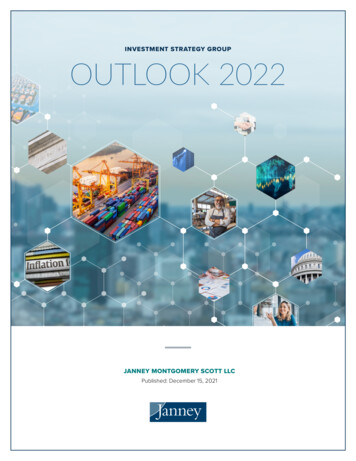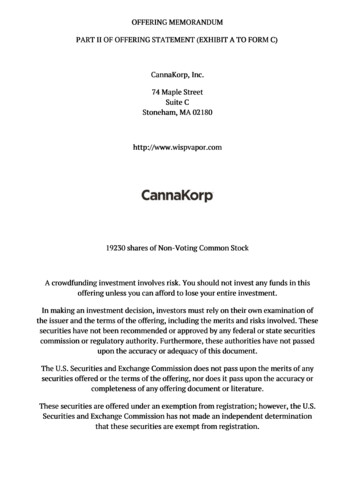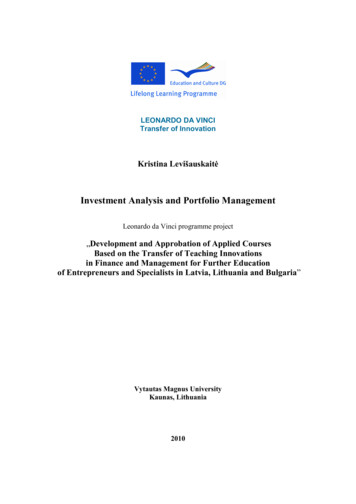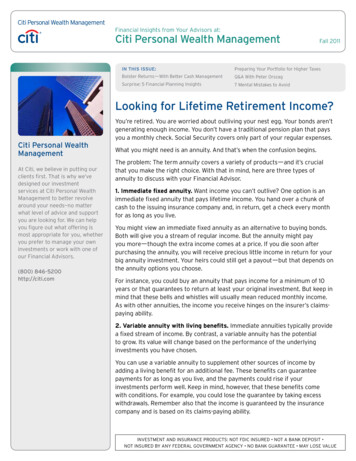
Transcription
Wealth Management Group2022 Investment Outlook
COVID-192021 began with rising hopes that new, effective COVID-19 vaccines – free and available to all – wouldresolve the worst public health crisis in more than a century before the year was out. Instead, we enter thefourth calendar year of the crisis still coping with a virus that is capable of disrupting our lives and oureconomy. Last year was even deadlier than the year before, and 820,000 have now perished in the U.S.,alone. The Centers for Disease Control and Prevention (CDC) is predicting another 44,000 will die in thefirst month of 2022, and the once unthinkable specter of 1-million American lives lost is becomingdepressingly credible. Globally, more than 5.4-million deaths have been attributed to this virus and itsmutations. The U.S., with barely 4% of the world’s population, has accounted for 19% of the world’scases, and 15% of its deaths.The Peterson Center on Healthcare and the Kaiser Family Foundation are partners in monitoring how wellthe U.S. healthcare system is performing. A Peterson-KFF study of hospitalizations in the JuneNovember period, during which time COVID-related hospitalizations more than tripled, showed that 85%of this increase was attributable to unvaccinated adults. There are still 90-million unvaccinatedAmericans who are 4-7 times more likely to be infected than those who are fully vaccinated, dependingon age, and 15-18 times more likely to require hospitalization. The encouraging news is that each newsurge in the virus seems to result in an uptick in vaccinations, apparently validating Churchill’s1
observation that Americans can always be counted on to do the right thing, but only after they’ve triedeverything else.Even as the original virus and its Delta variant continue to cause periodic, localized hotspots, a newvariant, less lethal to vaccinated persons but many times more infectious than the previous strains, createda new and even greater surge in infections as the new year beckoned . Omicron, though less dangerousthan previous variants, represented a new threat to our over-stressed and demoralized care healthcaresystem and the economy in general, due to its ability to spread so rapidly. Goldman Sachs lowered its2022 GDP growth estimate from 4.2% to 3.8% due to Omicron. College campuses began closing againand sporting events were postponed or canceled. School districts in Detroit, Los Angeles, Atlanta,Cleveland and Washington returned to virtual learning or delayed reopening after the Christmas break.More than 8,000 flights were canceled during the recent holiday season, largely due to an increase ininfections among airline employees and crews.From its outset, however, scientists had advanced the possibility that the increased transmissibility ofOmicron could mean that its wave would pass relatively quickly, and, indeed, case counts are alreadyshowing signs of cresting here in the U.S. There is every reason to believe that our experience will besimilar that of South Africa and the UK, where cases and hospitalizations rose rapidly over the course ofjust a month before falling back quickly.2
Finally, it should be said that if the fight against COVID has not gone exactly as planned, we are stillimmeasurably better off than we were a year ago. We have vaccines, if only people would get them. Weno longer have morgues set up outside of hospitals, where people were dying alone at alarming rates. Weare required to don masks and practice distancing in public, but we are once again in public, not isolated.Science’s efforts to produce a more sustainable response to the virus are bringing us closer to the daywhen we will be able to live with COVID as background noise, not a life-threatening event. And, theeconomy is much stronger today than it was a year ago, despite the COVID headwinds.Jobs and the EconomyNon-farm payrolls underperformed consensus expectations (again) in December, adding just 199,000 newjobs versus expectations for a 450,000 advance. That was the fewest number of new jobs added in anymonth of 2021. But the headline number understated (again) much of the underlying strength in the labormarket. This has been a recurring theme throughout 2021, with jobs reports missing expectations, only tobe revised upward in subsequent months. In the December release, the prior two months’ reports wererevised upward by 141,000 jobs. As has been the case in past months, the household survey, whichcounts workers not jobs and from which the unemployment rate is calculated, showed a strong gain of650,000 jobs for the month, and a 3-month average for employment gains of 723,000. Theunemployment rate dropped to a post-recession low of 3.9%. Personal income (wages paid time hoursworked) rose 0.8% month/month, suggesting continued robust demand.Still, as the labor market continues to tighten, job vacancies and the number of people leaving their jobsremains at record highs. Baby boomer retirements are one reason for this, but so is workerdiscouragement over mask and vaccine mandates, COVID fears and childcare concerns. Many others leftthe work force to start their own small businesses, as the number of start-ups grew as COVID spread. It’sestimated that up to 6-million who left their jobs earned enough from stock market or crypto gains toleave the labor force, at least temporarily. Many of these will return. Whatever the reasons, workershortages persist in critical industries such as retailing, restaurants, airlines, law enforcement, nursinghomes and hospitals, where workers are most at risk.Despite the unevenness in the monthly reports and the variability in the competing surveys, 2021 will godown as a year of record-breaking jobs growth. The U.S. economy officially added 6.4-million jobs lastyear, the most since 1939 when the government began keeping such records. Some analysts believe thatthe reported numbers understate the real numbers by at least a million jobs, but we are still not yet back tothe employment levels that existed pre-COVID (chart, following). Assuming that workers return to theworkforce as COVID’s threat wanes over time, the shortage of workers that is currently hamstringingbusinesses across many sectors of the economy is a relatively good problem to have, since it means thatthere are jobs available as the economy continues to reopen. That is the opposite of the challenge wefaced following the Great Recession of 2008-09.3
Other economic data is supportive of continuing strength in the economy. The ISM Manufacturing Indexeased slightly in December, but is still elevated at a healthy 58.7. A reading above 50 is indicative of anexpanding manufacturing sector. The New Orders Index, which is forward looking, remained above 60,suggesting continued strength in both capital spending and rising earnings expectations. Retail salesmissed expectations for the second straight month in December, but employment trends and wage gainsare supportive of strong demand going forward. The Conference Board’s Consumer Confidence Indexincreased sharply in December, following a slight increase in November.4
Inflation, Interest Rates and the Federal ReserveThe second biggest story of 2021 was the scourge of rising prices which turned the term, “transitory” intoa punch line and drove inflation to levels not seen since the 1980s. A key difference between then andnow, of course, is that the Fed Funds rate was close to 20% then, and is near 0% now.The Federal Reserve is behind the curve relative to the last cycle based on both growth and currentemployment metrics. The December jobs reports showed the unemployment dropping to 3.9%, and ratehikes aren’t expected to begin until June, or possibly March. When the unemployment rate fell below 4%during the last expansion phase, the Fed was already two years into a rate hike cycle. Even if the Fedwere to begin to shrink its balance sheet after the first quarter and hike rates four times this year (fasterthan previously expected), its policy would still be considered “accommodative” relative to the last cycle,when jobs – not inflation – were the main concern.Incomes are rising and the labor force is expanding, despite near-record numbers of people leaving theirjobs. Omicron could temporarily slow growth for a period, but in the current economic environmentweakness in one period would likely give way to a bounce in the next. The trend in demand growth isstill rising faster than the economy’s ability to produce goods in the face of persistent shortages of bothsupplies and labor.Still, the Federal Reserve is giving mixed signals despite its announced willingness to hike rates asnecessary to restrain inflation. On the one hand, minutes from the Fed’s December policy-makingmeeting indicate growing concern over rising prices, and an acknowledgment that the labor market isalready very tight and inflationary factors such as wage growth won’t be transitory. Several Fed officialshave said that the March FOMC meeting could be the time to begin raising short term rates, and thefinancial markets are increasingly discounting the probability of four rate hikes this year (chart,following).5
On the other hand, the Fed’s latest official projections, which accompanied the minutes of the Decembermeeting, were for an economy with above trend growth and unemployment below the level consistentwith the Fed’s inflation target, and inflation falling to 2.6% in 2022, 2.3% in 2023, and 2.1% in 2024.The incongruity lies in the fact that the Fed is projecting a fed funds rate of just 2.1% by the end of 2024,a pace of tightening far slower than most analysts deem necessary to restore price stability. Consensusexpectations are that short term rates will rise to near 2% by the end of 2023, a year earlier than the Fed’sprojections (chart, following).6
It’s been said that economic expansions have never died a natural death – rather, the Fed has killed them.Raising rates too aggressively is a risk to the economy and jobs, but the optimistic view in this instance isthat the Fed has a greater margin for error than is generally thought. With incomes, earnings and nominalGDP growth indicators strong and “real” interest rates deeply negative, the Fed has plenty of hikingleeway before it risks sending the economy into another downturn. By that view, inflation will remainelevated in 2022, but a level below 3% in 2023 will seem plausible as the economy slows, but doesn’tstall. The negative view is that the Fed has waited too long, and more aggressive tightening will berequired than would have been necessary otherwise. It’s a fine line to tread, and rate hikes that beginsooner rather than later and proceed at a quicker pace than the Fed currently projects would not be asurprise.A final point to be made about interest rates at the longer end of the curve is that the Fed is reducing theamount of its Treasury purchases just as the level of maturities is spiking. Other investors will need tostep up to buy new Treasury issuance, further putting upward pressure on interest rates. The 10-yearTreasury yield rose to 1.87% from 1.63% at the beginning of the year, and the 2-Year rate rose to 1.08%from 0.78% at the same time. Inflation and expectations for improving global growth are already creatingupward pressure on market interest rates, and the Treasury’s growing refinancing needs will likelyincrease that pressure (chart, following).7
A Timely Tax TipSince you have read this far, we thought that those of our readers with an appreciation of the absurdwould enjoy the following bit of tax advice offered by the Internal Revenue Service. This is apropos ofabsolutely nothing else in this Outlook.On December 16th, The IRS put out Publication 17 to assist individuals in preparing their 2021 taxreturns. Page 76 of this helpful document includes the admonition that, “If you steal property, you mustreport its fair market value in your income in the year you steal it, unless you return it to its rightful ownerin the same year. It is to be included on Schedule 1, Form 1040, or on Schedule C if from a self employment activity.”In a related Facebook post, the Erie County Sheriff’s Office in Buffalo has offered support for all carthieves who need help with an itemized list of property they stole, so it can be reported on their incometaxes. The post includes a dedicated phone line, and an assurance that a Deputy or Detective would behappy to meet you with your list.We did not make either of these things up.8
The Stock MarketBy any standard, the current bull market is approaching historical proportions. The S&P 500 delivereddouble-digit gains for the third straight year in 2021, generating a return of 28.7% including dividends.Over the last three years, the S&P has more than doubled on a total return basis, marking its first 100% 3-year return since the tech bubble of the late 1990s.There have been 92 rolling 3-year periods since 1928, and the S&P 500 has returned 100% or more just 7times, mostly during the period of recovery from the 1929 crash, the post-World War II boom, and thedot-com bubble of the late 1990s. What makes the most recent period so remarkable is that the Index hadto overcome a 34% decline as COVID shut down the economy in early 2020, wiping out all the gains thathad been earned over the prior four years. This means that all of the market’s most recent performancewas the result of the 113% gain it achieved in just 21 months from the March 2020 low to its recentDecember high! (chart, following).9
The trailing 5 and 10-year returns are approaching historic levels as well. The S&P 500’s annualizedreturn of 16.5% over the last decade equates to a 361% return over that time, surpassing the post-’29recovery period and approaching the levels achieved during the post-war years and the pre-dot.com era.Equally noteworthy is the fact that as returns have accelerated, volatility, as measured by the standarddeviation of annual returns has fallen to historically low levels as well.10
Diversification Has Not HelpedIf the market has been exceptionally rewarding to investors over the last decade, and particularly the latterstages of the last decade, it has also presented a number of challenges for investment managers.Investments in U.S. large company stocks form the core of most domestic portfolios, including ours, butallocations to a variety of other asset classes such as small cap and international stocks are commonlyseen as a way to minimize volatility and optimize risk-adjusted returns. Diversification is explicitlyrequired of fiduciaries under the Uniform Prudent Investor Act in managing trust assets. But on a trailing3-, 5-, and 10-year basis, diversification has significantly detracted from investment performance as smallcap and international equity benchmarks have underperformed the S&P 500 by wide margins – and haveexperienced greater volatility, as well.Index Returns and 1Yr3Yr AnnualizedS&P 500MSCI EAFE5Yr Annualized10Yr Annualized10Yr StandardDeviation-5.00%Russell 2000Bloomberg Barclays AGGOn a year-by-year basis, small cap stocks have not been additive to performance since 2016, andinternational stocks have underperformed U.S. stocks every year since 2017. Bonds still provide ameasure of risk control in portfolios, but current yields provide a lower level of income than aconservative stock portfolio, and bonds are unlikely to generate positive total returns if interest rates riseas expected and bond prices fall. Emerging markets, every analyst’s favorite a decade ago, havegenerated annualized returns of less than 5%. Hedge Funds have experienced only mid-single digitreturns on an annualized basis, and gold less than 2%. The U.S. stock market over the recent period hasoften been referred to as the TINA market – There Is No Alternative. We would not disagree.11
Active Managers Have Under-performedAnother challenge for active managers has been that the S&P 500 has been an increasingly difficultbenchmark to match. According to Morningstar, 85% of active U.S. stock funds were trailing the S&P500 through November, a worse performance than 2020 when 64% of active funds under-performed. In away, this is similar to the diversification issue discussed above – just as diversification into asset classesother than U.S. large cap stocks has negatively affected performance, so too has diversification within theU.S. stock market lessened the chances of generating better-than-market returns.We have commented repeatedly in past Outlooks that market performance is being increasingly driven byjust a handful of stocks whose large market capitalizations disproportionately affect the index. The 10largest stocks in the S&P 500, 2% of its members, account for 30% of its capitalization and contributed49% of all of the price gains in the Index in 2021. Microsoft ( 52%), alone, accounted for more than 10%of the S&P 500’s performance; and Microsoft, along with the next 4 largest stocks, Apple ( 35%), Nvidia( 125%), Alphabet ( 65%), and Tesla ( 50%), accounted for 42% of the market’s rise for the year. Infact, this is a phenomenon that has been accelerating over the last 5 years. Performance has been soconcentrated in the largest stocks that if one had simply owned the 5 largest companies in the index eachyear during that time, he or she would have quintupled their money, a return of 400%. By comparison,The S&P 500 returned “only” 133% during that time.There are a number of important takeaways from the increasing concentration of mega-cap growth stocksat the top of the S&P 500 Index.The first is that investors should not be misled into thinking that their own experience should mirror the“market”, so long as they define the market as the S&P 500. For example, when the S&P 500 was just12
4% below its 52-week high recently, nearly half of the 500 stocks in the index had declined at least 10%from their highs, and nearly 1 in 5 had declined at least 20%.For investors who follow the NASDAQ composite, the divergence is even more striking as that index iseven more top-heavy than the S&P. Of the 10 largest stocks in the S&P 500, 6 also trade on theNASDAQ. Apple, which carries a 6.83% weighting in the S&P 500, accounts for 10.67% of theNASDAQ Composite. While the 10 largest stocks in the S&P 500 comprise just over 30% of the index,the 10 largest NASDAQ stocks comprise 47% of that index, which lists more than 2,500 stocks asmembers. This has allowed a recent meltdown in the NASDAQ to go virtually unnoticed, as 40% of thestocks in the composite fell 50% or more below their 52-week highs while the NASDAQ Composite,itself, charged merrily upward.Indexers Beware: Valuations Matter - EventuallyInvestors in index funds must be feeling especially validated these days, given the inability of mostinvestment managers to outperform their benchmarks during the markets stunning rise over the last 3years – and particularly over the last 21 months. But passive investors would be well advised to take aserious look at what they really own.13
They are now invested in an index that is concentrated to a greater degree than ever before in a few large,expensive growth stocks (chart, below). Their 10 largest holdings, which comprise nearly one-third of theindex, are now trading at more than 33 times forward earnings estimates, a multiple that is 68% abovetheir weighted average over the last 25 years, and nearly 60% greater than the index, itself. Note, also,that as the weighting and P/E multiples of these few stocks have expanded, their collective contribution toS&P earnings has begun to decline as the economy improves and cyclical value stocks benefit.Meanwhile, virtually ignored in the market’s steady march to 68 new highs in the last year, alone, is theuniverse of the remaining 490 stocks which are trading at a nearly 10% discount to the index and a 41%discount to the so-called top 10. Valuations – especially relative valuations – are not necessarily goodpredictors of near term performance, but they matter in the long run.“Probable Surprises”Byron Wien, former Senior U.S. Investment Strategist at Morgan Stanley and currently Vice Chairman ofBlackstone Advisory Partners, annually publishes a list of economic, market and political surprises,which he defines as events that the average investor would probably assign a 1 in 3 chance of occurring,but which he believes are probable. Sadly, no record exists of his career batting average, but the list isalways thought provoking and we are enclosing an edited list of the more relevant “probable surprises”from his 37th edition, published earlier in January.14
“The combination of strong earnings clashes with rising interest rates, resulting in the S&P 500making no progress in 2022. Value outperforms growth. High volatility continues and there is acorrection that approaches, but does not exceed, 20%.” “While the prices of some commodities decline, wages and rents continue to rise and theConsumer Price Index increases by 4.5% for the year. Declines in prices of transportation andenergy encourage the die-hard proponents of the view that inflation is “transitory,” but persistentinflation becomes the dominant theme.” “The bond market begins to respond to rising inflation and tapering by the Federal Reserve, andthe yield on the 10-year Treasury rises to 2.75%. The Fed completes its tapering and raises ratesfour times in 2022.” “In spite of the Omicron variant, group meetings and convention gatherings return to prepandemic levels by the end of the year. While COVID remains a problem in both the developedand the less-developed world, normal conditions are largely restored in the U.S. People return totheaters, concerts and sports arenas en masse.” “The price of gold rallies by 20% to a new record high. Despite strong growth in the U.S.,investors seek the perceived safety and inflation hedge of gold amidst rising prices andvolatility.” “While the major oil-producing countries conclude that high oil prices are speeding up theimplementation of alternative energy programs, these countries can’t increase production enoughto meet demand. The price of West Texas crude confounds forward curves and analyst forecastswhen it rises above 100 per barrel.” “The digital economy gets a major boost when Jamie Dimon reverses his position oncryptocurrencies and J.P. Morgan seeks to become a leader in the space. Crypto becomes a majorfactor in the financial markets.”2022 OutlookThere seems to be no consensus regarding the market’s outlook in the coming year. Bank of Americabelieves that the S&P 500 will be at or near current levels a year from now, held back by tighteningmonetary policy but supported by the fact that the expected returns from other asset classes, i.e., bonds,are even less appealing. BofA believes that the economy is over-stimulated, noting that policymakersadded 9-trillion to the economy in 2021 after injecting 23-trillion in 2020, support that is now beingwithdrawn.Morgan Stanley is in the same camp, citing strong earnings growth of 8-10%, but P/E multiplescompressing back closer to their historical norms. Their year-end target of 4400 for the S&P is virtuallyflat with current levels.15
Others, like Northern Trust, JP Morgan and Federated Hermes are more constructive, basing their view ona global economy returning to trend growth as COVID becomes less disruptive and supply chain issuesare gradually resolved. Federated’s year-end target is 5300 on the S&P, more than 20% above currentlevels despite projected earnings gains of just 9%. The market’s P/E would have to expand to 23 timesearnings to support their price target, which they claim is justified in view of negative real interest rates.What is striking about the current round of forecasts is that, while the various firms have wildly divergentviews of market performance going forward, there was general consensus among them on corporateearnings, inflation, Fed policy, COVID’s path and GDP growth. Their differences lay mainly in how theanalysts thought the market would react to each of these concerns; in other words, what would matter andwhat would not. This brings to mind an observation, often made, that the optimist believes that we live inthe best of all possible worlds. The pessimist fears that this is true.Apart from historically high equity valuations, our primary concerns for the economy and the capitalmarkets remain COVID, supply chains, inflation, and Federal Reserve policy. And we need to be awarethat these are interdependent - not independent – concerns.COVID is a mutating virus, and it is likely now a permanent part of our lives. But even as the virus in itsvarious forms retains the ability to create temporary disruptions to some sectors of our economy, themarket appears to be increasingly unfazed by this risk. We expect COVID’s impact will continue to fadeas more tests and new treatments come on line in the coming months and years.We expect that supply chain issues will persist so long as COVID remains a global concern, as the variantwaves are not synced from country to country, nor are the policies that countries implement to deal withits public health effects. There is near universal agreement that supply chains will remain stressed at leastthrough 2022, but there are too many moving parts to this to have great confidence in any projection ofwhen this will cease to be a concern. We will simply have to deal with what is in front of us.Regarding inflation, our position could best be described as “guardedly concerned.” This is to say that weare willing to be pleasantly surprised if the Fed’s own projections of 2.6% in 2022 and 2.3% in 2023 areactually achieved, but we are not preparing for that eventuality. Shortages of goods are persisting anddemand shows no signs of slowing down, based on the available data. Overlay this with the fact that theFed is so far behind the curve compared to past cycles that even an acceleration of Fed rate hikes beyondwhat is currently expected could still be considered “accommodative” in the context of the currenteconomic data. Analysts’ opinions are mixed on whether the Fed can keep inflation from being imbeddedat current levels, but they are virtually unanimous in saying that Fed policy error is the single greatestthreat to the economy and the markets.The Elephant in the RoomNo outlook would be complete without an objective look at valuations. Everyone acknowledges thatvaluations have been stretched to their extremes, but there seems to be far more interest in finding facts tojustify current valuations than in actually considering what current valuations may portend for futurereturns. As Homer Simpson once said, “Facts are meaningless. You can use facts to prove anything that’seven remotely true. Facts schmacts.”16
We have been guilty of brushing aside valuation concerns, ourselves, arguing in past Outlooks that themarket’s high valuations were inflated by the out-performance of that handful of mega-cap growth stockswe spoke about at length earlier. If we look past those names, we reasoned, valuations for the rest of themarket were reasonable. That is all true, but for many investors, particularly those with short timehorizons, it may not matter. A severe market correction would almost certainly bring down the prices ofall stocks, not just the over-valued and over-hyped growth stocks. The likelihood that “value” sectorswould decline much less in such an event would probably be scant comfort to those whose risk toleranceis low, or whose time horizon is not long enough to recover their losses. You can’t pay the rent with“relative” performance.The fact is that the market’s rise over the last 10 years, and particularly over the last 21 months, hasresulted in the highest valuation levels since the dot.com bubble of 1999-2000. This is true not just on aprice/earnings basis, but also relative to book value, cash flow and dividends. It is only when comparingthe current earnings yield (the reciprocal of the P/E ratio) to current bond yields do stocks appear to beundervalued, but bond yields have almost surely bottomed (charts, following).17
On a macro basis, the total market capitalization of all U.S. stocks has grown to almost 200% of GDP.The last (and only) time this broad measure approached even 140% of GDP was, again, during the periodleading up to the bursting of the tech bubble at the end of the last century. The average ratio of stockmarket capitalization / GDP, globally, is barely 105%, based on the average of the world’s 62 largesteconomies. U.S. stock market capitalization now represents 61% of the world’s total, despite the fact thatthe U.S. accounts for only 23% of the world’s GDP.As recent market weakness has brought the S&P 500 down very close to the 10% threshold that definesan official “correction,” we should remember that the market had not experienced a pullback of more than5% from any high in more than 16 months. Considering the market’s previous gains and its historically18
high valuation in the face of the headwinds of a less accommodative Fed and rising market interest rates,a meaningful market correction should not really be a surprise.For long term investors with the patience, means and fortitude to remain fully invested through themarket’s inevitable cycles, we stand by our observation that there are fairly valued opportunities that areobscured by the S&P’s inflated multiple. Drug stocks with generous dividend yields are trading atmultiples of below 10 times earnings; shares of medical device companies which collapsed as electivesurgeries were postponed due to COVID, should rebound as the virus’ effects lessen in the coming years.Manufacturing activity remains strong despite supply chain issues, supporting the share prices ofindustrial stocks, and this sector should benefit even more as the global economy returns to trend growth,however slowly. Rising inter
Wealth Management Group 2022 Investment Outlook. 1 COVID-19 2021 began with rising hopes that new, effective COVID-19 vaccines – free and available to all – would . November period, during which time COVID-re










